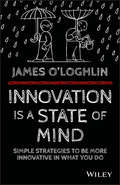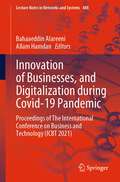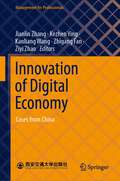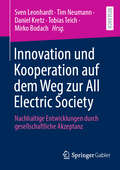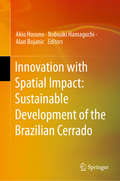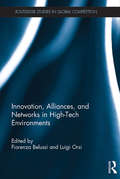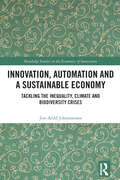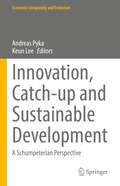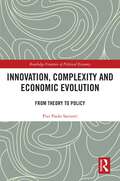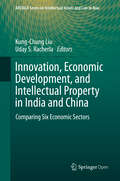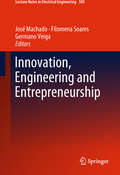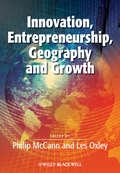- Table View
- List View
Innovation is a State of Mind
by James O'LoghlinA modern framework for practical innovation--from individual ideas to an innovative organisational culture Everyone says that innovation is important. The problem is that no one tells you how to be innovative. Innovation is a State of Mind sets out a step-by-step guide to creating innovative ideas and putting them into action. You'll learn how to generate more ideas with greater potential, how to grow and evaluate them, test their effectiveness and then implement the ones that are going to improve your business. Author James O'Loghlin has worked with over a thousand of Australia's best inventors and innovators in the eight years he hosted ABC-TV's The New Inventors. He studied what they do differently and how they are able to identify and take advantage of opportunities that the rest of us miss. Packed with engaging stories and a good dose of humour, this insightful guide helps you to make innovation a part of what you do every day. Change your thinking and identify overlooked opportunities Step around common roadblocks to innovation Generate better ideas, and find the ones that will improve your business Create a culture where innovation is part of everyone's job Harvest innovative ideas from the entire staff and find the ones that will make a difference Innovators see things differently. They solve problems that the rest of us can't, and create solutions to problems that we never noticed we had. Getting stuck in routine and procedure is the death knell for modern business. Most companies undervalue and underuse the creative potential of their people, because they underestimate the impact of continuous innovation. Innovation is a State of Mind shows you how to think like an innovator and create a culture of innovation, so you can stay out in front of the future of business.
Innovation leben!: Wie Sie in Ihrem Unternehmen Zukunftspotenziale erkennen, beurteilen und heben
by Lena LuhrmannInnovation ist ein Wettlauf gegen Mitbewerber und gegen die große überall lauernde Unbekannte, die Überflüssigwerdung. Der Druck im Nacken, auch zu denen an der Spitze zu gehören, die schlaflosen Nächte, wenn man merkt, dass das Innovationsbestreben wieder mal vertagt worden ist, weil es, oberflächlich betrachtet, nicht drängt. Die Angst, dass man eines Morgens aufwacht, der Markt gekippt ist und man von heute auf morgen von einem 10 Personen Start-up aus einer Garage in Wanne Eickel überholt worden ist. Dieses Buch hilft, aus einer anderen Perspektive auf das Thema Innovation zu blicken - und zwar auf allen Hierachieebenen und aus Sicht verschiedener Bereiche, in denen Innovationen eine Rolle spielen. Es beleuchtet, woran Innovation immer noch und immer wieder scheitert, obwohl alle notwendigen Techniken und Budgets aufgefahren wurden. Lena Lührmann zeigt, was auf Bauch- und Kopfebene, zwischenmenschlich und haptisch passiert, wenn Menschen an Innovation denken oder sich damit befassen. Sie möchte so das Bewusstsein bei Führungskräften und Entscheidern in Unternehmen dafür wecken, was ihre Mitarbeiter in Sachen Innovation leisten oder auch nicht. Nur wenn die Leser sich selbst und ihr Unternehmen in dieser Hinsicht verstehen, werden sie in der Lage sein, aus allen wirklich großartigen Techniken die für sie passende herauszufinden. Anhand vieler "Aha-Momente" werden sie die im Buch beschriebenen Problematiken aus der Praxis in ihrem eigenen Unternehmen identifizieren und angehen können. Ziel soll sein: - Innovationsfähigkeitslevel beurteilen, - Innovationchancen erkennen, - Innovation mitmachen, - Innovation beurteilen, - Innovation leben, ganz natürlich aus dem Selbstverständnis des Unternehmens heraus. Jedes Kapitel umfasst drei Aspekte, um sich dem Thema zu nähern: Key Aussagen, Fakten und Lösungen, persönliche Erlebnisse der Autorin.
Innovation of Businesses, and Digitalization during Covid-19 Pandemic: Proceedings of The International Conference on Business and Technology (ICBT 2021) (Lecture Notes in Networks and Systems #488)
by Allam Hamdan Bahaaeddin AlareeniThis book constitutes the refereed proceedings of the International Conference on Business and Technology (ICBT2021) organized by EuroMid Academy of Business & Technology (EMABT), held in Istanbul, between 06–07 November 2021. In response to the call for papers for ICBT2021, 485 papers were submitted for presentation and inclusion in the proceedings of the conference. After a careful blind refereeing process, 292 papers were selected for inclusion in the conference proceedings from forty countries. Each of these chapters was evaluated through an editorial board, and each chapter was passed through a double-blind peer-review process.The book highlights a range of topics in the fields of technology, entrepreneurship, business administration, accounting, and economics that can contribute to business development in countries, such as learning machines, artificial intelligence, big data, deep learning, game-based learning, management information system, accounting information system, knowledge management, entrepreneurship, and social enterprise, corporate social responsibility and sustainability, business policy and strategic management, international management and organizations, organizational behavior and HRM, operations management and logistics research, controversial issues in management and organizations, turnaround, corporate entrepreneurship, innovation, legal issues, business ethics, and firm gerial accounting and firm financial affairs, non-traditional research, and creative methodologies.These proceedings are reflecting quality research contributing theoretical and practical implications, for those who are wise to apply the technology within any business sector. It is our hope that the contribution of this book proceedings will be of the academic level which even decision-makers in the various economic and executive-level will get to appreciate.
Innovation of Digital Economy: Cases from China (Management for Professionals)
by Kanliang Wang Jianlin Zhang Kezhen Ying Zhigang Fan Ziyi ZhaoThis book presents a rich selection of 36 real-world cases on how organizations in China explore the new growth pattern, business model innovation, and digital transformation in digital era. The topic of cases varies from digital marketing and Internet brands, the growth of digital platforms, digital transformation and the industrial Internet of things, strategies for cross-border e-commerce companies, and business model innovation in digital era, etc. These cases stem from a diverse set of industry sectors, reporting on best practices and lessons learned. The book shows how organizations strive to find new ways to develop and create new paths to grow in a digital world and shares essential practical insights into digital economy. All cases are presented in a standardized structure in order to provide valuable insights and essential guidance for practitioners, scholars as well as general readers.
Innovation performance accounting
by Matthias Hartmann Hermann Mohnkopf Gerhard Metze Wilhelm SchmeisserFor successful innovation in business the responsible managers need a consistent view of the individual processes as well as an assessment of key projects in all phases of the development. Generating new ideas, fast examination of its feasibility requires skilled methods for evaluation of these ideas, plans and especially costs and revenues. Business models, calculation methods and some assessments of certain options are presented by the authors. The ability to identify risks and appropriate responses to misperceptions are important milestones in the innovation process. From analysis of problems to the introduction of market-ready solutions, legal requirements, business demands and risk management systems are discussed. Concepts promoting uniform, binding rules for ratings in the innovation process are treated. The identification of target pricing, target costing and litigation, the evaluation of the solution to calculate risk aspects as tasks in financial management and innovation controlling are part of the content. The authors demonstrate that any innovation in different industries requires a strategic and financial project management. Monetary assessment of the individual processes, a detailed patent portfolio and accounts management for innovation processes are of enormous importance. The book is completed by applications of the Berlin Balanced Scorecard Concept with practical examples from the innovation projects in pharmaceutical and technical business.
Innovation to the Core
by Rowan Gibson Peter SkarzynskiIf you're like most business leaders, innovation now tops your corporate agenda. But despite all the talk and excitement about the importance of innovation, managers have so far found scant help for innovating in a systematic way that fuels consistent growth and sustained success.In Innovation to the Core, Strategos CEO Peter Skarzynski and business strategist Rowan Gibson change all that. They share the accumulated wisdom from Strategos--the consulting firm Skarzynski co-founded with Gary Hamel that helps clients instill innovation into their very core. Drawing on a wealth of stories and examples, the book shows how companies of every stripe have overcome the barriers to successful, profitable innovation. You'll find parts devoted to crucial topics--such as how to organize the discovery process, generate strategic insights, enlarge your innovation pipeline, and maximize your return on innovation. Frequent hands-on tools--frameworks, checklists, probing questions--help you put the book's ideas into action.Crafted in close coordination with Gary Hamel--the man who Fortune magazine has called "the world's leading expert on business strategy"--Innovation to the Core is the definitive fieldbook for making innovation a core competence in your organization.
Innovation und Kooperation auf dem Weg zur All Electric Society: Emergenzen für neue Geschäftsprozesse
by Tim Neumann Tobias Teich Sven Leonhardt Daniel Kretz Mirko BodachDas Buch bietet einen Handlungsrahmen für Praktiker und Wissenschaftler, es zeigt Problembereiche sowie kreative Lösungsansätze beim Transfer von Innovationen auf dem Weg zur All Electric Society (AES). Es werden Innovationen und (branchenübergreifende) Kooperationen aus betreffenden Bereichen, wie bspw. Digitalisierung, Mobilität, Gesundheits- u. Pflegewirtschaft sowie Energieversorgung, aber auch Transformation von Organisationen, Prozessen, Politik, Regulatorik und Gesellschaft betrachtet.
Innovation und Kooperation auf dem Weg zur All Electric Society: Nachhaltige Entwicklungen durch gesellschaftliche Akzeptanz
by Tim Neumann Tobias Teich Sven Leonhardt Daniel Kretz Mirko BodachDeutschland beschleunigt den Ausstieg aus fossilen Energieträgern und setzt auf CO₂-neutrale Energie als Leitenergie der Zukunft. In diesem Zusammenhang ist das Ziel die Erschaffung eine „All Electric Society“ (AES), in der die Sektoren Verkehr, Wohnen, Industrie und Gewerbe energetisch verknüpft und optimiert werden. Um die Versorgungssicherheit zu gewährleisten, werden neue Modelle, Methoden und Technologien benötigt. Dazu zählt die beschleunigte Entwicklung innovativer, nutzerzentrierter Technik, unterstützt durch gesellschaftliche Beteiligung. Die Fortsetzung dieses Sammelbandes bietet einen Handlungsrahmen für Praxis und Wissenschaft, indem sie Herausforderungen und Lösungsansätze für den Innovations- und Kooperationsprozess in Bereichen wie Digitalisierung, Mobilität, Gesundheitswesen, Energie und gesellschaftliche Transformation beleuchtet. Ziel ist, kreative Lösungsansätze und branchenübergreifende Kooperationen aufzuzeigen, um den Übergang zur AES erfolgreich zu gestalten.
Innovation und Kreativität in Chinas Wirtschaft: Deutsch-chinesische Kooperationen: Grundwissen, Erfahrungen und Erkenntnisse
by Doris Gutting Min Tang Sebastian HofreiterDieses Buch vermittelt deutschen Unternehmen grundlegende Einblicke in Chinas Wirtschaft mit einem speziellen Fokus auf Innovations- und Kreativitätsmanagement. China gilt als eine der Supermächte in der digitalen Transformation und in Schlüsseltechnologien, und auf dem Weg in die digitale Zukunft ist auch deutsches Know-how gefragt. Sowohl in China als auch in Deutschland sind Innovation und Kreativität wichtige Triebkräfte für eine nachhaltige und konkurrenzfähige Wirtschaft. Wissenschaftler und Praktiker diskutieren in diesem Buch aus ihrer jeweiligen Perspektive die aktuelle deutsch-chinesische Zusammenarbeit, chinesische Führungs- und Wertekultur, nachhaltige und soziale Innovationen, Social-Media-Ansätze sowie technologische Innovationen, insbesondere im Handel. Die Experten beleuchten interessante chinesische Projekte, Phänomene und Herangehensweisen und bieten Einsichten in hocheffiziente und erfolgreiche chinesische Denk- und Vorgehensweisen. Ein Buch für alle Verantwortlichen in Unternehmen, die Aktivitäten im chinesischen Markt oder die Zusammenarbeit mit chinesischen Organisationen planen, oder sich von chinesischen Herangehensweisen inspirieren lassen wollen.Weitere Mitwirkende sind unter anderen: Dr. Nikola Bachfischer, innovaMe LAB, MünchenDr. Birgit Breninger, Universität SalzburgProf. Dr. Thomas Herdin, Universität SalzburgProf. Dr. Thomas Königbauer, Hochschule für angewandtes Management, IsmaningDaniel Müller, Ostasiatischer Verein, German-Asia-Pacific Business Association, HamburgTim Naumann, Ventum Consulting China, Shanghai Prof. Dr. Doreen Pick, Hochschule MerseburgProf. Pierre Rafih, Hochschule für angewandtes Management, IsmaningDr. Barbara Scharrer, GSK Rechtsanwälte, MünchenProf. Dr. Joel T. Schmidt, Hochschule für angewandtes Management, Ismaning
Innovation under the Radar: The Nature and Sources of Innovation in Africa
by Xiaolan FuInvestigating the nature, drivers and sources of innovation in Africa, this book examines the channels for effective diffusion of innovation in and to Africa under institutional, resource and affordability constraints. Fu draws on almost a decade of research on innovation in Africa to explore these issues and unpack the process, combining a rigorous statistical analysis of a purposely designed multi-wave, multi-country survey with in-depth studies of representative cases. Building on this research, Fu argues that African firms are innovative but unsupported. Those 'under-the-radar' innovations that widely exist in Africa as a result of the constraints are not sufficient to enable Africa to leapfrog the innovation gap in the era of the fourth Industrial Revolution. This is the first comprehensive analysis of the creation and diffusion of innovation in low income countries. It also provides the first survey-based analysis of innovation in the informal economy.
Innovation versus Financialization in the US Pharmaceutical Industry (Elements in Corporate Governance)
by William Lazonick Öner TulumMandated by the Inflation Reduction Act of 2022, the US government is negotiating with pharmaceutical companies over the 'maximum fair price' of ten drugs widely used by Medicare patients. The pharmaceutical companies contend that a 'fair' price is a 'value-based price' that enables their shareholders to capture the value the drug creates for society and warn that lowering drug prices will reduce investments in new drugs. This Element responds to these arguments by showing that pharmaceutical companies (a) should have their drug prices regulated, given scale economies in supplying drugs and price inelasticity of drug demand; (b) use their profits from unregulated drug prices to distribute cash dividends and stock buybacks to shareholders; (c) do not typically rely upon investment by shareholders to fund drug innovation; and (d) benefit from 'collective and cumulative learning' in foundational and translational research that is antecedent and external to their investments in clinical research.
Innovation with Spatial Impact: Sustainable Development Of The Brazilian Cerrado
by Akio Hosono Nobuaki Hamaguchi Alan BojanicThis book is unique and original, constituting a pioneering study in the use of spatial economics and related analytical approaches to Brazil’s Cerrado agricultural development and the formation of agro-industrial value chains. This methodology is appropriate because Cerrado agriculture has been developed from scratch in a vast, previously barren area (204.7 million ha.) in which a spatial transformation has taken place. Until 40 years ago, this region, with its huge expanse of tropical savanna was believed to be unsuited to agriculture. Now, however, it has been transformed into an immense breadbasket, contributing to the mitigation of global food shortages. It also has contributed to the inland development of Brazil, promoting urbanization with a higher living standard and modern production techniques. This book identifies critical factors that enabled the transformation of the Cerrado. To understand the process of agricultural development and the formation of agro-industrial value chains, spatial economics and related approaches are essential because the process involves spatial interactions such as transportation, supply chains, knowledge spillovers, environmental constraints, migration, and urbanization. The book demonstrates that the initial development of Cerrado agriculture was a genuine spatial transformation with contributions from pioneering producers, agribusinesses, and central and local governments, as well as through international cooperation. It also discusses agriculture and agro-industrial value chains focusing on inclusive and sustainable development, a major concern of the international community particularly in terms of the Sustainable Development Goals.
Innovation, Alliances, and Networks in High-Tech Environments (Routledge Studies in Global Competition)
by Fiorenza Belussi Luigi OrsiRecent years have seen a growth in strategic alliances, mergers and acquisitions and collaborative networks involving knowledge-intensive and hi-tech industries. However, there have been relatively few studies looking at this form of collaboration as a strategy to drive firms’ innovative performances. This book specifically focuses on the role of strategic alliances, M&A and innovation networks, providing insights on if and how they contribute to boosting firms’ innovation performances. The book has a double purpose. Firstly, it investigates at an industry level the role played by the alliance, M&As and networks in high-tech environments such as biotechnology, pharmaceutical, software and nanotechnology in creating, transforming and reshaping the dynamics inside and between industries. Secondly, it explores the impact at the firm level of factors such as cognitive distance, management capabilities, and relational and social capabilities, on firms’ global innovation capacity, measured as innovation quantity, innovation quality and innovation novelty. The book will be of interest to scholars working on the economics of innovation, innovation management studies, strategic management, regional science and evolutionary economics, among other areas.
Innovation, Automation and a Sustainable Economy: Tackling the Inequality, Climate and Biodiversity Crises (Routledge Studies in the Economics of Innovation)
by Jon-Arild JohannessenEconomic inequality, the environmental crisis and the climate crisis are systemically linked. Accordingly, they should be understood as a single, interconnected system and strategies for resolving them should be guided by this understanding. This book demonstrates how the Green New Deal and its systemic alternative, the Red New Deal, could influence the course of these three global crises, all within the context of the Fourth Industrial Revolution.The author has developed several scenarios that are relevant to the automation that will result from advances in artificial intelligence and intelligent robots. The first is one of mass unemployment, while the second envisages low rates of unemployment, although workers will experience stagnation and then a decline in their wages. It is possible to envisage a different set of scenarios; however, we must replace the capitalist economic model with a different model: mutualism, a sustainable model that would allow for economic growth while also addressing the three current systemic crises. The author argues that if such a model is implemented, there will be jobs for everyone and the climate crisis will be tackled because people’s welfare will be prioritized over profit. We can assert that such a model will foster the development of economic equality. The basic premise of this mutual and sustainable economic model is that sustainability is in everyone’s interests.The book employs not only established and innovative methods, such as literature reviews, scenario thinking and historical methods, to underpin its arguments, but also conceptual generalization as an intellectual tool to tackle the general research problem; thus, it will be an invaluable resource for scholars and students of sustainability and the innovation economy.
Innovation, Catch-up and Sustainable Development: A Schumpeterian Perspective (Economic Complexity and Evolution)
by Keun Lee Andreas PykaThis volume presents selected contributions from the 2018 conference of the International Schumpeter Society (ISS). The selected chapters in this volume reflect the state-of-the-art of Schumpeterian economics dedicated to the three conference topics innovation, catch-up, and sustainability. Innovation is driving catch-up processes and is the condition for a transformation towards higher degrees of sustainability. Therefore, Schumpeterian economics has to play a key role in these most challenging fields of human societies’ development in the 21st century. The three topics are well suited to capture the great variety of issues, which have the potential to shape the scientific discussion in economics and related disciplines in the years to come. The presented contributions show the broadness and high standard of Schumpeterian analysis. The ideas of dynamics, heterogeneity, novelty, and innovation as well as transformation are the most attractive fields in economics today and offer the most prolific interdisciplinary connections now and for the years to come when humankind, our global society, has to master the transition towards sustainable economic systems by solving the grand challenges and wicked problems with which we are confronted today. Therefore, the book is a must-read for scholars, researchers, and students, interested in a better understanding of innovation, catch-up, and sustainability, and Schumpeterian economics in general.
Innovation, Commercialization, and Start-Ups in Life Sciences
by James F. JordanInnovation is the translation of a new method, idea, or product into reality and profit. It is a process of connected steps that accumulates into your brand or reputation. However, there can be many pitfalls and wrong turns on the road to realizing this goal. Innovation, Commercialization, and Start-Ups in Life Sciences details the methodologies ne
Innovation, Commercialization, and Start-Ups in Life Sciences
by James F. JordanInnovation is a translation of a new method, idea, or product into reality and profit. It is a process of connected steps that accumulates into a brand reputation required for success. Unlike Fortune 500 companies, whose projects are self-funded, a start-up must simultaneously have a value proposition that attracts a customer (for revenue), investors (for capital), and acquirers (for a liquidity event or IPO). A high percentage of start-ups fail before attaining positive cashflow, due to a variety of reasons that are detailed in this book.Avoiding the pitfalls and wrong turns are the goals of this book. Innovation, Commercialization, and Start-Ups in Life Sciences details the methodologies necessary to create a successful life science start-up from initiation to exit. Written by an expert who has worked with more nearly 500 life science start-ups, this book discusses specific processes and investor milestones that must be navigated to align customer, funder, and acquirer needs. Successful commercialization requires attention to multiple constituents, such as investors, regulators, and customers. Investors require liquidity for their return, which is achieved through selling their stock in a public or private sale. The reader will gain an appreciation for the necessary data, partnerships, and skills needed to create a competitive and sustainable company. The author discusses such specific issues as customer problems, demonstrating sales access, and ensuring intellectual property is impervious to competitive advancement. This book is intended to be suitable for entrepreneurs, venture capitalists, and investors in both business and academic settings. These organizations have specific departments, such as R&D, operations, business development, legal, regulatory, and marketing, that would also benefit from this book.FEATURES Focuses specifically on life science start-ups Examines how to determine a company valuation and future "fundable milestones" Explores how to align regulatory and clinical strategies Discusses intellectual property derived from a university or individual through formation to exit. Reviews how start‐ups must simultaneously meet the needs of multiple constituencies at once: investors, regulators, customers and exit candidates James F. Jordan is an author, consultant, and speaker. He is a Distinguished Service Professor of Healthcare & Biotechnology Management, a former Fortune 100 executive, and a managing director of a venture fund.Access the Support Material: https://healthcaredata.center/ Cover design by Sarah Mailhott.
Innovation, Complexity and Economic Evolution: From Theory to Policy (Routledge Frontiers of Political Economy)
by Pier Paolo SaviottiIf evolutionary economics is to compete with neoclassical economics as a general-purpose economic theory, it needs to incorporate new aspects of socioeconomic reality, such as institutions of all types, including technical, scientific, and political. Furthermore, evolutionary economics needs to be able to provide policy implications at least as interesting as those of neoclassical economics. Thus, as this book argues, evolutionary economics must become evolutionary political economy. Innovation plays a central role in the book, but not in the sense of providing a technologically determinist interpretation. Rather, the book argues that innovations do not emerge in isolation from other components of socioeconomic systems but coevolve with institutions, infrastructures and organizational forms. This concept of coevolution is absolutely central in the book and provides a link with theories of complexity. In addition to providing an epistemological basis for evolutionary economics, the link with complexity and coevolution offers the connection with evolutionary political economy. Innovations and technologies do not emerge and develop in an institutional vacuum, but interact with existing institutions and reshape them, in addition to inducing the formation of new institutions. In this process, technologies and institutions reinforce each other providing a potential mechanism to transform socioeconomic systems. The book also explores the policy implications of these innovative societies, where wealth is created but unequally distributed. The book is addressed to open-minded economists, social scientists who are dissatisfied with the approach of neoclassical economics, technologists and policy makers.
Innovation, Democracy and Efficiency: Exploring the Innovation Puzzle within the European Union's Regional Development Policies (Palgrave Advances In Regional And Urban Economics)
by Raffaella Y. Nanetti Francesco GrilloInnovation, Democracy and Efficiency.
Innovation, Democracy and Efficiency: Exploring the Innovation Puzzle within the European Union’s Regional Development Policies (Palgrave Advances in Regional and Urban Economics)
by Raffaella Y. Nanetti Francesco GrilloEndogenous growth theory has significantly impacted most of the developing and developed countries, shifting priorities of industrial policies towards innovation. In line with this trend, the European Union significantly increased its budgetary allocation for R&D. However, statistical data show a weak correlation between R&D expenditure and the acceleration of economic growth. Regional innovation policies display divergent returns according to different institutional conditions and policy choices.Grillo and Nanetti attempt to understand the reasons that lie behind differences in performance. Their results show that better performing innovation strategies require the following factors: clear choices of locally congruent smart specialization; strong capacity of public investment to stimulate additional private investment; clear distribution of responsibilities for decision-making and independence of policy implementation from political interference; and problem solving partnerships amongst innovators, universities, and governments that pre-exist the programmes. These factors point to a relationship between democracy (defined as openness of policy-making) and innovation (as technology-enabled growth) which is explored throughout this book.
Innovation, Economic Development, and Intellectual Property in India and China: Comparing Six Economic Sectors (ARCIALA Series on Intellectual Assets and Law in Asia)
by Kung-Chung Liu Uday S. RacherlaThis open access book analyses intellectual property codification and innovation governance in the development of six key industries in India and China. These industries are reflective of the innovation and economic development of the two economies, or of vital importance to them: the IT Industry; the film industry; the pharmaceutical industry; plant varieties and food security; the automobile industry; and peer production and the sharing economy.The analysis extends beyond the domain of IP law, and includes economics and policy analysis. The overarching concern that cuts through all chapters is an inquiry into why certain industries have developed in one country and not in the other, including: the role that state innovation policy and/or IP policy played in such development; the nature of the state innovation policy/IP policy; and whether such policy has been causal, facilitating, crippling, co-relational, or simply irrelevant. The book asks what India and China can learn from each other, and whether there is any possibility of synergy.The book provides a real-life understanding of how IP laws interact with innovation and economic development in the six selected economic sectors in China and India. The reader can also draw lessons from the success or failure of these sectors.
Innovation, Employment and Growth Policy Issues in the EU and the US
by John T. Addison Paul J.J. WelfensThe EU and the U.S. confront distinct factor market dynamics and common policy challenges. Labor market developments and long-term changes in capital markets and capital flows represent key problems in aging societies. The analyses presented here compare the European and U.S. patterns in this regard. Moreover, Schumpeterian innovation dynamics as well as energy policy issues receive attention. Considerable differences in innovation dynamics are reported across countries. The book charts the role of different innovation systems and knowledge societies and highlights different policy approaches. Another focus is upon structural changes and innovation in open economies. Finally, medium and long-term options for transatlantic cooperation are evaluated against the backdrop of the Lisbon agenda.
Innovation, Engineering and Entrepreneurship (Lecture Notes in Electrical Engineering #505)
by Filomena Soares José Machado Germano VeigaThis book presents endeavors to join synergies in order to create added value for society, using the latest scientific knowledge to boost technology transfer from academia to industry. It potentiates the foundations for the creation of knowledge- and entrepreneurial cooperation networks involving engineering, innovation, and entrepreneurship stakeholders. The Regional HELIX 2018 conference was organized at the University of Minho’s School of Engineering by the MEtRICs and Algoritmi Research Centers, and took place in Guimarães, Portugal, from June 27th to 29th, 2018. After a rigorous peer-review process, 160 were accepted for publication, covering a wide range of topics, including Control, Automation and Robotics; Mechatronics Design, Medical Devices and Wellbeing; Cyber-Physical Systems, IoT and Industry 4.0; Innovations in Industrial Context and Advanced Manufacturing; New Trends in Mechanical Systems Development; Advanced Materials and Innovative Applications; Waste to Energy and Sustainable Environment; Operational Research and Industrial Mathematics; Innovation and Collaborative Arrangements; Entrepreneurship and Internationalization; and Oriented Education for Innovation, Engineering and/or Entrepreneurship.
Innovation, Entrepreneurship and the Informal Economy in Sub–Saharan Africa: A Sustainable Development Agenda (Sustainable Development Goals Series)
by Ayodotun Stephen Ibidunni Oyedele Martins Ogundana Maxwell Ayodele OlokundunSet against the backdrop of a rising population in Africa and the lowering opportunities for white collar jobs, as well as the continent’s limited access to resources, this edited collection demystifies the interconnectedness between the factors and actors involved with innovation and entrepreneurship development in sub-Saharan Africa’s (SSA) informal economy for more effective, result-oriented outcomes.Exposing the underlying motivations that define uniqueness in Africa’s innovation and entrepreneurship ecosystem, particularly in the informal sector, the editors argue that there is a significant knowledge gap that this book seeks to fill, concerning institutionalization, motivational factors and the harnessing of the innovative potentials of Africa’s informal sector entrepreneurs and their supporting role in achieving a more sustainable African regionBy identifying patterns of domesticating entrepreneurship theories and showcasing the latest research, the book covers awide array of topics that discuss a multidisciplinary and multicultural perspective to entrepreneurship theory and practices in Africa. In this way the book contributes to the goals of SDG 9 ('Build resilient infrastructure, promote inclusive and sustainable industrialization and foster innovation') in Africa.
Innovation, Entrepreneurship, Geography and Growth (Surveys of Recent Research in Economics)
by Les Oxley Philip McCannInnovation, Entrepreneurship, Geography and Growth provides a timely, accessible review of our understanding of the complex links between innovation, entrepreneurship, geography and growth. Expert contributions provide a thorough roadmap of the developments in research at the interface of these themes. A timely and accessible review of our understanding of the complex links between innovation, entrepreneurship, geography and growth A highly comprehensive roadmap of the range of issues addressed by research in these areas Discusses the most profitable ways forward for enhancing our understanding of arising issues Contributions from leading experts in the field take a variety of theoretical, empirical and institutional angles
